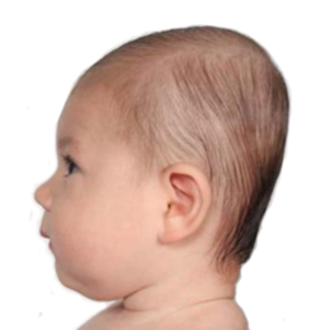What is Flat Head Syndrome and why does it occur?
Flat Head Syndrome (known medically as plagiocephaly or brachycephaly) is just like it sounds. It is when a flat spot develops on the back or side of a baby’s head. Flat Head Syndrome is very common among babies. The American Academy of Pediatrics reports that as many as 50% of babies may have some degree of flat head syndrome. Babies have very soft bones that make up their skull. This makes for an easy exit from the birth canal during delivery. But it also means that your baby’s head is very susceptible to developing flat spots. Babies are especially susceptible to flat spots during the first 4 months of life because they are not able to reposition themselves or roll over on their own.

How do I know if my baby has Flat Head Syndrome?
A few signs you can look for to determine if your baby has flat head syndrome are:
- An obvious flat spot anywhere on your baby’s head – in the back or on either side
- Asymmetry of your baby’s head when you look at it from the top view – it could look slanted or misshapen
- Uneven ears that look like one is higher than the other or one is more forward than the other
- Protrusion of the forehead on one side when you look at it from the top view
- Noticing that your baby prefers the same head position
Is Flat Head Syndrome just a cosmetic issue?
First, let’s talk about why Flat Head Syndrome is not just cosmetic! You might be thinking that it’s “just a little flat spot” and your baby’s hair will eventually cover it. But, let’s think about it in a different way. When you first start to notice a flat spot, it might not look that concerning. But, left unattended, a flat spot will only continue to get worse causing a whole host of other problems. Your baby’s flat spot could be an indicator that she has underlying muscle imbalances or developmental issues that need to be addressed. Even if your baby does not have underlying problems, the flatness itself still needs to be addressed. Until your baby’s head starts to round back out, the rapid growth her head is experiencing will continue to grow somewhere else. This is why you might see protrusion of the forehead or uneven ears or facial features. This can cause lifelong problems with vision, hearing, jaw alignment, ear infections and sinus issues as the asymmetry continues to get worse.
My baby HAS a flat spot, what can I do?
If your baby is one of the many dealing with a flat spot, the good news is that most cases of Flat Head Syndrome CAN be reversed with proper treatment! In this post, I will give you some practical tips that you can do to help your baby’s head begin to round back out! If you have read my post “5 TIps to Preventing Flat Head Syndrome” then some of these tips might look familiar. Oddly enough, the same tips to help prevent a flat spot can also be used to help round your baby’s head back out.
Positioning
When your baby is small, before they can roll or reposition themselves on their own, they pretty much stay wherever you put them. This is great for taking a shower or using the bathroom, but it can be problematic when it comes to a flat spot. The best thing you can do is pay attention to the positions in which you are putting your baby. If your baby’s flatness is on one side, then try to position your baby with her head turned in the opposite direction. Some critical positions to look at are:
- In the carseat – what side is your baby turning her head to look out the window?
- On the changing table – which direction is your baby turning her head to look at you or the room?
- In the crib/bassinet – which way is your baby looking to see her room? What direction is your baby’s head turned while she sleeps?
- In the highchair – what side is your baby turning her head to look across the table or into the other room?
- While eating – which way is your baby turning her head to eat?
If your baby has already developed a flat spot, it is a good idea to change up all of her positions to avoid pressure on the flat spot as much as possible. If it seems overwhelming to change all of these things at once, then choose one or two scenarios that your baby spends the most time in, such as sleeping and feeding.
Active Play
Although babies sleep a lot in the first few months, they also have plenty of wake time. You need to be mindful of her flat spot during these times as well. Tummy time and sidelying are great positions to utilize to reduce pressure on the back of your baby’s head. You don’t want to eliminate playtime on her back altogether, but just be mindful of how much time baby is spending on her back. Try to limit playtime with pressure on the flat spot and alternate positions frequently. Using a boppy and baby-wearing are also great tools to use during wake times as well!
Limit Containers
This is a BIG one! I recommend that ALL parents limit containers. But, when your baby has developed a flat spot, I really recommend eliminating containers all together! Most baby containers (bouncers, swings, rock n’ plays, etc) are made from soft material that cradle your baby’s head and limit movement. It is almost impossible to eliminate pressure on your baby’s flat spot if they are in a container. If you absolutely must use a container, I would limit it to 5 minutes or less at a time and no more than 15 minutes a day. This means absolutely no sleeping in a container! I know this sounds extreme, but it is critical to rounding your baby’s head back out! The also applies to your baby’s car seat. Use the car seat only when in the car and take your baby out of the car seat as soon as you are out of the car, even if they are sleeping.
Get Everyone On Board
This tip is especially important! If you are a working mom, then someone else is taking care of your baby for a large part of the day. Consistency is key to have success in eliminating your baby’s flat spot, so getting all of your baby’s caregivers on the same page is important. Make sure that your baby’s caregivers understand why your baby’s flat spot is not just cosmetic and come up with a game plan for implementing these tips into your baby’s entire day. Work with your caregiver to show them different ways to position your baby in her crib, on the changing table and during feeding times.
Seek Help
As we discussed earlier, a flat spot is not just cosmetic and can be an indicator that your baby has an underlying muscle imbalance or developmental issue. If you notice that your baby has a flat spot, you should reach out to your baby’s pediatrician immediately. Some doctors will maintain the school of thought that the flat spot will “work itself out,” however, I really encourage you to be an advocate for your baby and ask for a referral to a physical therapist. A physical therapist with experience dealing with plagiocephaly will be able to assess your baby’s muscles and development and identify any issues that need to be addressed. A therapist will also help you customize a plan for reversing the flat head syndrome. I promise we aren’t scary! Therapists just serve as another member of your team to help your baby reach her full potential!
Don’t Stress
As moms, we are hardwired to stress about everything when it comes to our kids. We feel like we should always be doing more or doing something better/differently. If your baby has a flat spot, I want you to take a deep breath and say this out loud: “THIS IS NOT MY FAULT. I AM A GOOD MOM. WHEN I KNOW BETTER, I CAN DO BETTER. WE WILL BOTH MAKE IT THROUGH THIS!” Now give yourself a hug and move forward using these simple tips!

Be the first to comment